
Saturday August 13, 2011
|
|
What's better than a slot car review? Well... nothing, I know. However when we get the chance to review two cars at the same time
you know we're not going to pass up the chance. So when I opened the box and found two cars of course I was excited. Then after seeing that both
were Citroen models it just made sense to slap them on the track at the same time for a side-by-side comparison right?
Comparing two cars side by side does allow a quick look at the cars similarities. Both are a 'blueish' color, both are 4-door
sedans, both are based on rally inspired race cars, both have unusual narrow rear track widths and both carry the name Citroen. Occasionally,
however, being able to review two cars at the same time can actually be some what of a bad thing. How? Well for starters it really showcases
differences between models, be that performance or fit and finish and in this case both cars might have several things in common yet it doesn't
take long to see some glaring differences.
Here at the end of our review I find myself having mixed feelings about both cars. The DS 21 is the better running of the two, so
its a real shame it has the fit and finish problems that it does. The 2 CV on the other hand is okay as a magnet car, a little disappointing as
a non-magnet car however its the nicer car in the fit and finish department and scores an extra point or two just because its an 'odd' little
car. Honestly though, unless the older Citroen models are just that popular with the European crowd I can't help but think both of these cars were made
with more of a collector in mind. Both the 2 CV and DS21 are strange cars that I would think would lack some appeal to the majority of racers
here in the States. Still... I suppose some credit should be given to SCX for making rather unique models that offer us even more options and
diversity for our beloved slot car racing hobby. Special
Thanks to SCX WorldWide for sending the Citroen 2 CV and DS 21 for review! Copyright © 2011
HomeRacingWorld.com All Rights Reserved
Saturday August 13, 2011
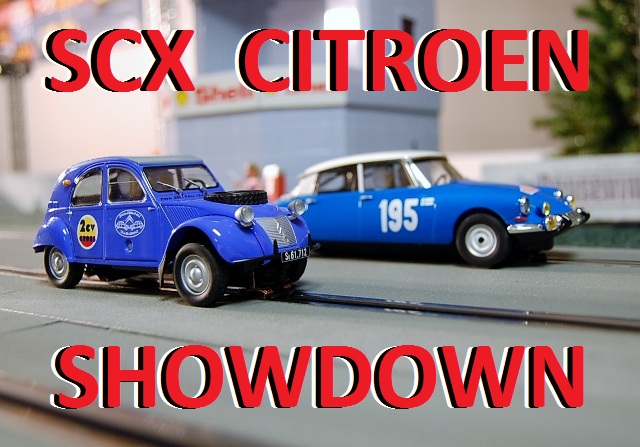
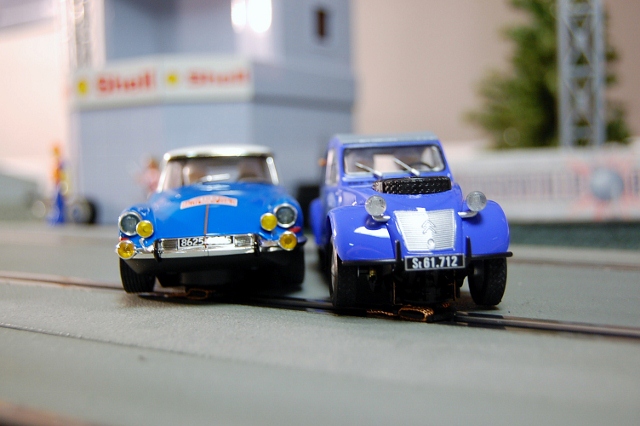
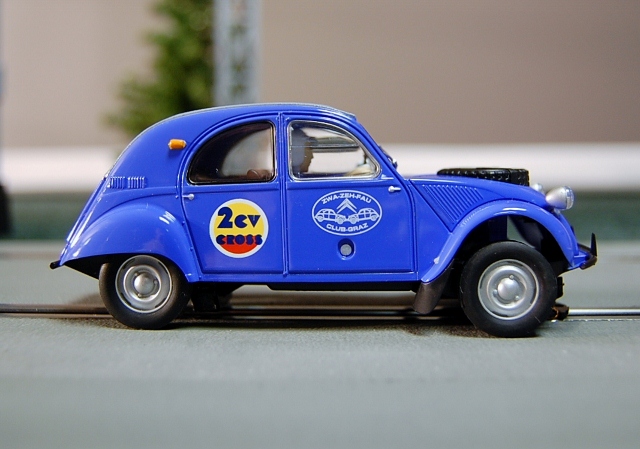
Let's start with the most obvious differences. The Citroen 2 CV (above) is a tiny and narrow little car where as the DS21 (below) is considerably
longer and wider.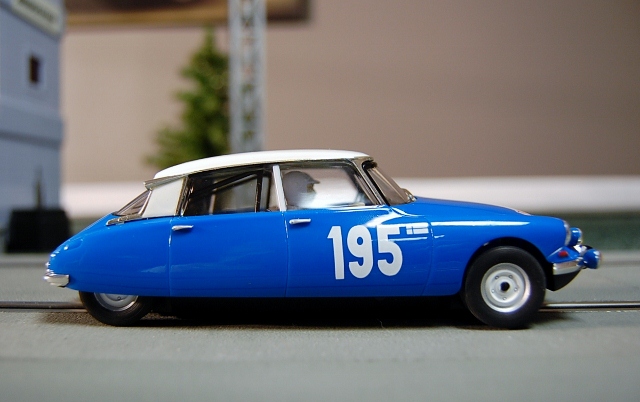
First looking at the smaller 2 CV the car has no lack of details to catch your eye. At the front you'll find a thin bar-style front bumper, stalk
mounted headlights and a strapped down spare tire mounted firmly in the center of the hood.
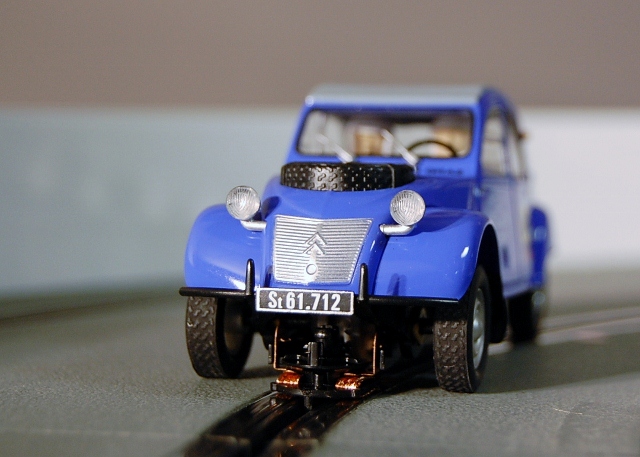
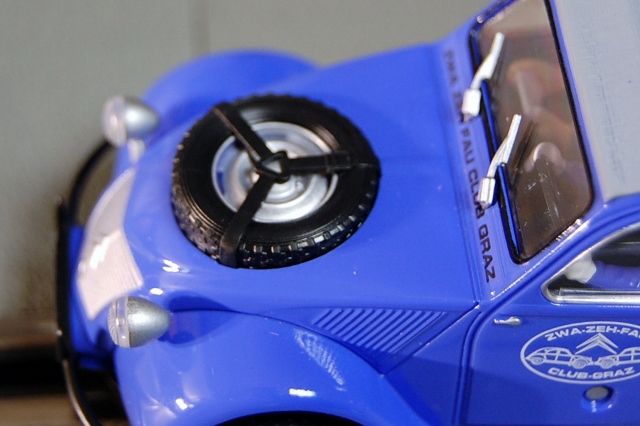
The roof is textured and painted to look like a canvas removable roof, sorry about the lack of focus in the image as SCX has done a nice job here
simulating the roof.
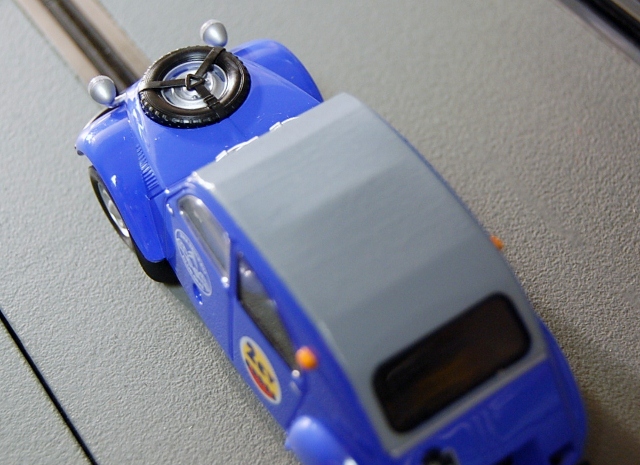
The side boats suicide front doors, which at first I didn't notice the handle locations and the front doors have simulated split windows. The side
graphics are opaque and besides the door handles I noticed different colored window frames in both the front and back doors.
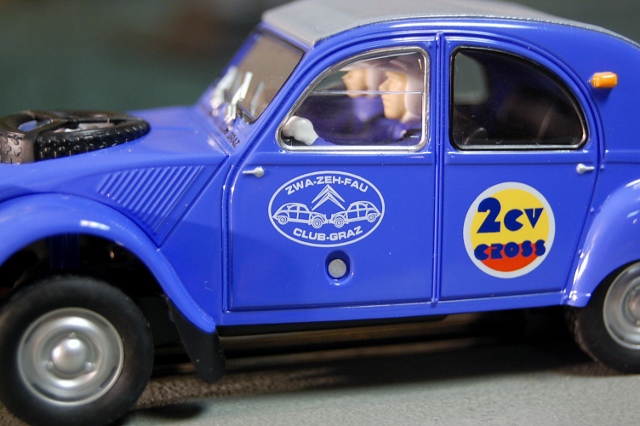
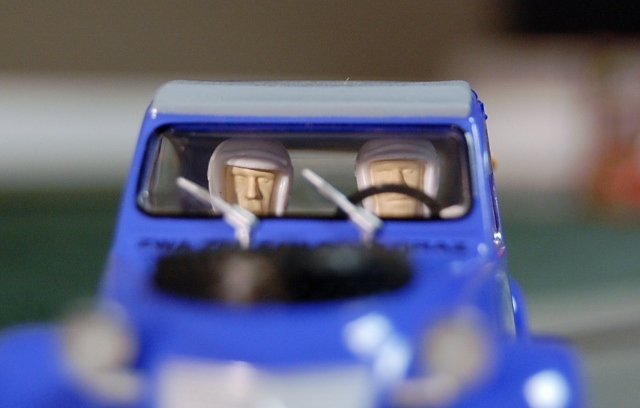
Interior room in such a small car is clearly lacking. I get the suspicion that both drive and co-driver we banging shoulders over rougher terrain
of the course. Both figures have unpainted face details, the dirve is wearing white driving gloves while the co-driver appears to be bare-handed
and they no doubt would get lost as the directions on his navigation notes are blank.
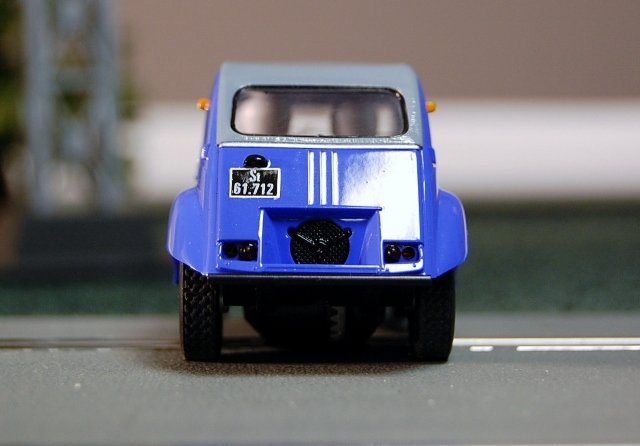
At the back here again we find tiny styling with a black rear window frame, a thin silver bar where the canvas top meets body, a painted on rear
plate, another very thin bar-style bumper, tiny lights and a black engine cooling fan rounding out the details. Right above the fan my lighting
makes it look as if there are three silver painted lines there however that is really body colored raised lines molded on the body.
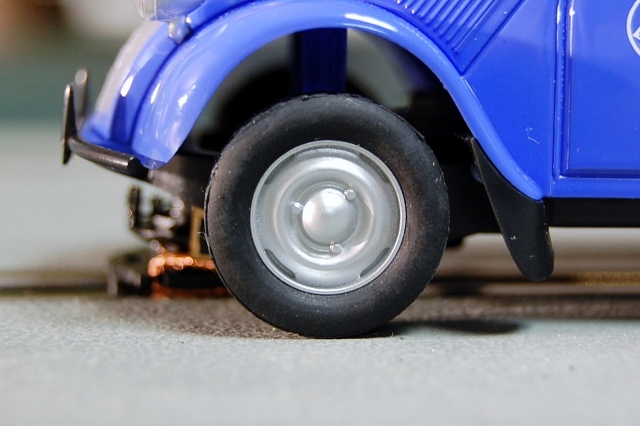
The very thin steel wheels are in a 3-lug pattern and are fitted with skinny treaded tires that almost look diamond-plate in pattern. There are
large black rock guards behind each of the front wheels to protect the body from rocks being tossed up by the treaded rubber also. Here you can
also see the giant tire to fender gap on this car and if you look through the fender opening can make out body posts that come down right on
top of the bushings in the front of the chassis.
Visually speaking the Citroen 2 CV might be an awkward looking little car but SCX has done a really nice job with it. I found no real glaring
issues with the fit or finish which is something I can not say for its sister car. That said...
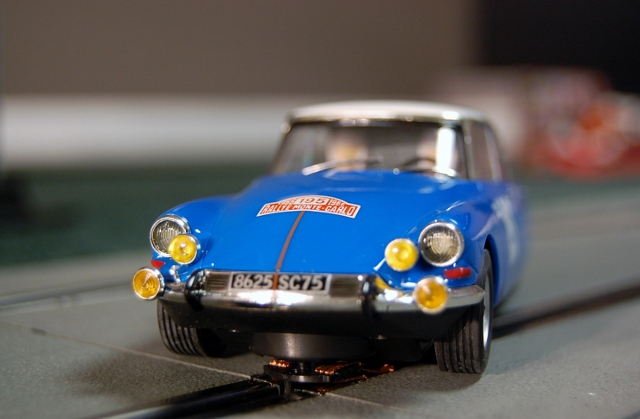
From a detail perspective I have no issues with the Citroen DS 21. I love the chrome grille-work, the multiple amber colored driving lights and the
chrome trim rings on the headlamps.
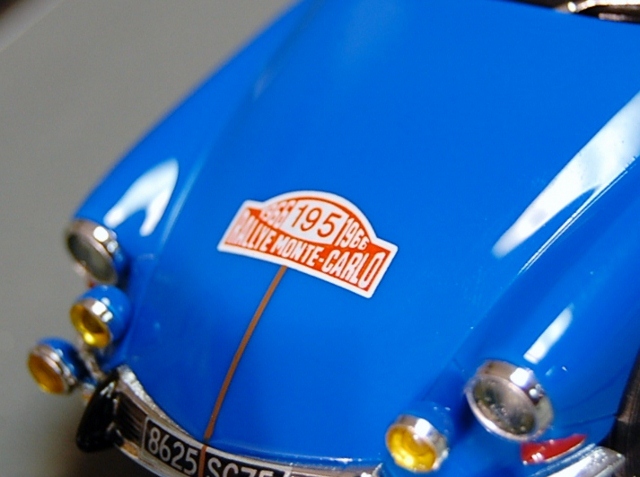
The blue body paint is very pretty and shiny with some some very, hardly worth mentioning specs of dust in the finish. The 1966 Rallye Monte-Carlo
graphic does have faint signs of bleed through but here again you only notice it if you are trying to be critical of something.
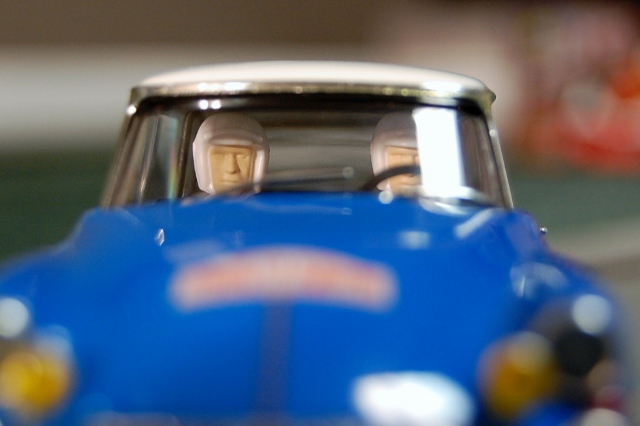
Our drivers have a bit more shoulder room on the larger DS 21 although by their expressionless faces they look no more excited to be driving this
car. Might again be because of a lack of instructions on the co-drivers hand held notes or it 'could' be because of some problems we'll point out
in a second.
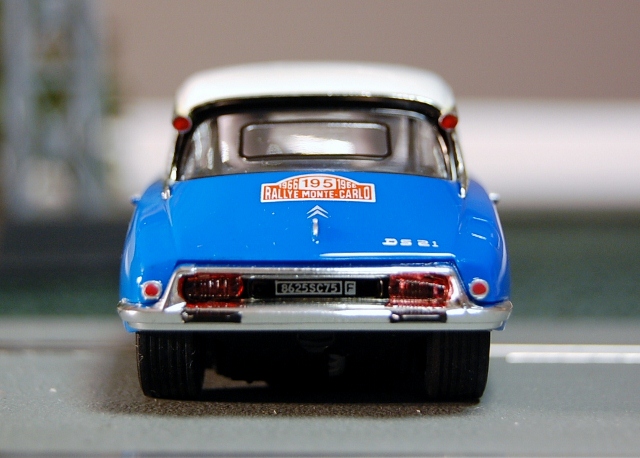
The back of the DS 21 is again pleasing to my eyes. I really appreciate the detail SCX attempted here with bumper trim, painted trim lights, painted
rear hatch handle and dual bar Citroen graphic. Notice also the molded in, framed rear window detail and the very tiny printed rear plate.
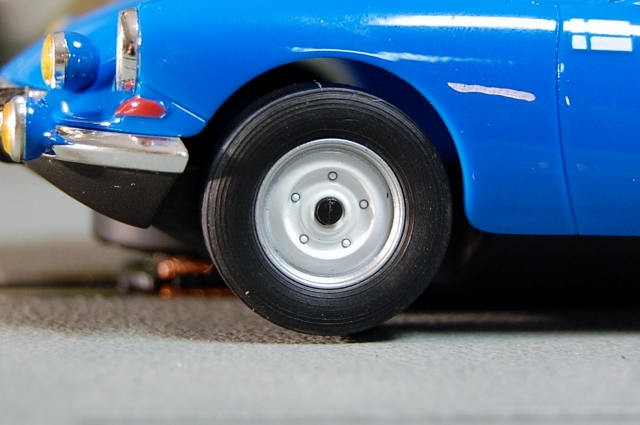
Our Citroen DS 21 is fitted with a 5-lug white painted steel wheel that is fitted grooved, not treaded, rubber tires that have a slight bit of
side-wall texture. You may also notice the black painted center on the wheels however that is not paint you see but rather the black plastic
end of the pin style holder on the front wheels. Yep... independent spinning front wheels for this model.
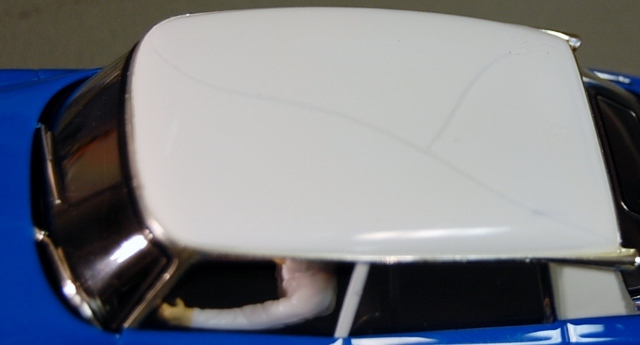
This is the part of reviewing cars that most of us dread... talking about the problems. With today's production standards finding problems feels
like a rare circumstance however our Citroen DS 21 is clearly one of those 'It's quitting time on Friday so lets send this one out the door'
type of cars. In this reviewer's opinion this car should have never been placed in the case and allowed to leave the factory and here is why...
I know my camera didn't focus very well on the roof (above) but I think you should be able to make out the very clear cracking in the paint on the roof.
This is something that had to have happened before final assembly and should have been stopped before it was attached to the chassis. What looks like
shaded lines in the paint are actually cracks, much like what you would find on an egg shell and you can drag your thumb nail over them and your
nail will catch on them making clicking sounds. I wish my camera focused on this better as its worse than the blury photo can show.
Sure.. this can be a very isolated one car problem however in my opinion the quality assurance
at the SCX factory should have pulled this one out before allowing it to be boxed. And this isn't the only problem with the car.
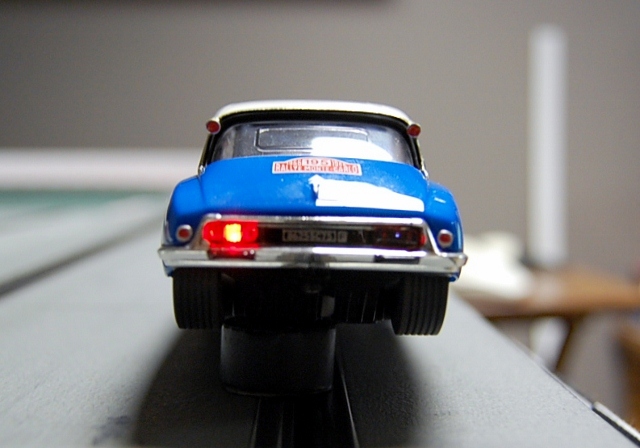
Here is the other problem I have with this car. Right out of the case, placed on the track and a quick pull of the trigger I saw this (above)...
So here we have a brand new, never driven car with two pretty serious defects that no doubt would have this car being returned, if the shop keeper
didn't already notice the giant paint defect on the roof. I didn't even buy it and I felt almost cheated a little after seeing the paint problem
right away and then finding a light not working from the get go. Now I've had SCX cars where a light has failed not long after running it but this,
thankfully, is the first car I've tested where it didn't work from the first pull of the trigger.
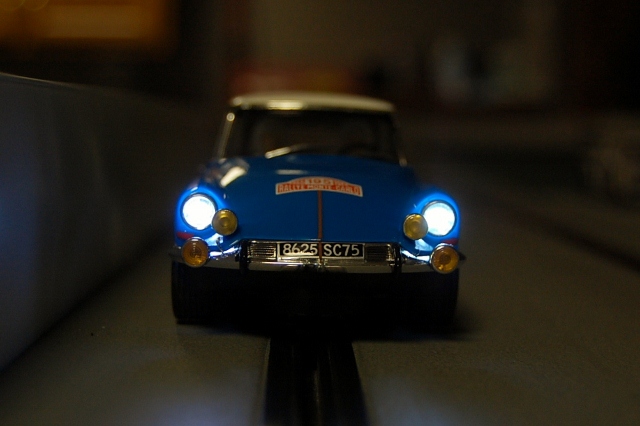
The front lights, for now anyway do work wonderfully although selfishly I really was hoping that the amber driving lights were going to light up as
well. That said, there is one thing I can complain about in regards to lights but this time its on the smaller 2 CV car.
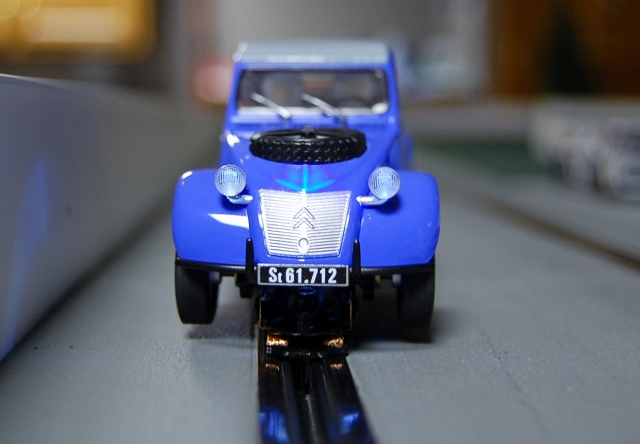
I had a sneaking suspicion this was going to happen as the headlamps are mounted on very small plastic stems sticking out of the body. From a 'scale'
standpoint sure this has to be done this way but it seriously stops the light transmission from the single LED mounted in the center of the hood
from reaching the clear headlights themselves. You can see in the image above that the center is the hood is glowing blue, as is the wall to the left
of the car with the blue light flooding out of the giant fender gaps and the track rails glowing as the light escapes out of the bottom of the
chassis. In comparison the rear lights work great.
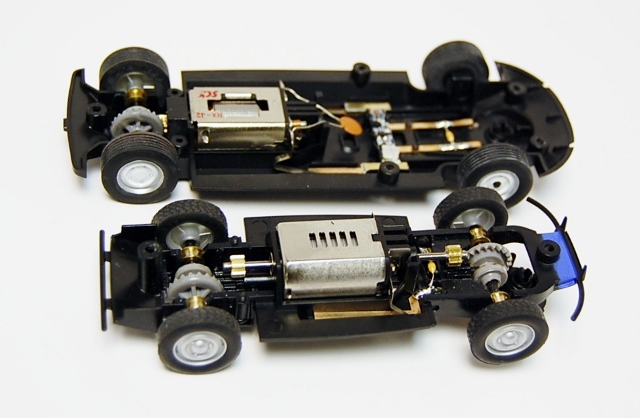
Okay... time to put the exteriors aside and get a closer look as the mechanicals. Here again the two couldn't be much more different. The longer DS 21
is set up in a rear wheel drive configuration with independent front wheels where the smaller 2 CV is an all-wheel drive car with the unique
multi-gear drive line as you can see from the image above the pinions do not touch the crowns.
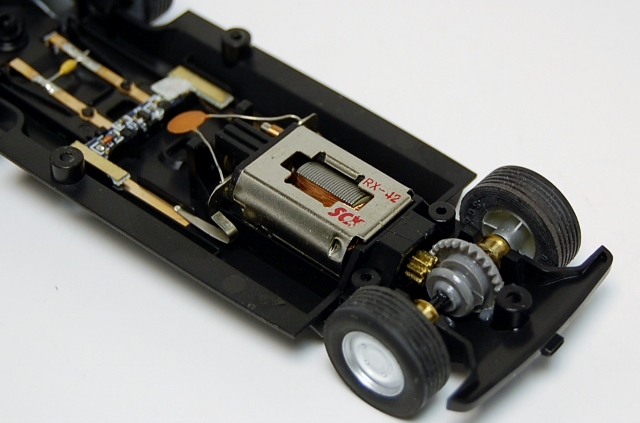
Here you can see the DS 21 is powered by an in-line RX42 motor fitted with a brass pinion spinning a grey plastic crown. The axle rotates in brass
axle bushings.
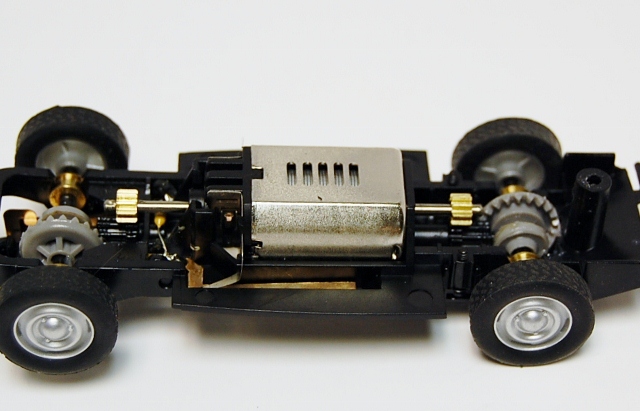
The smaller 2 CV, again with the all wheel drive, is fitted with dual brass pinions that turn black plastic cogs that in turn make contact with the
grey plastic crowns. There are brass bushing here at all four corners.
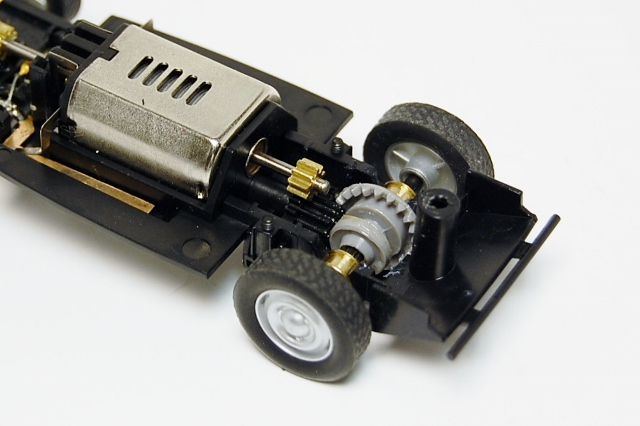
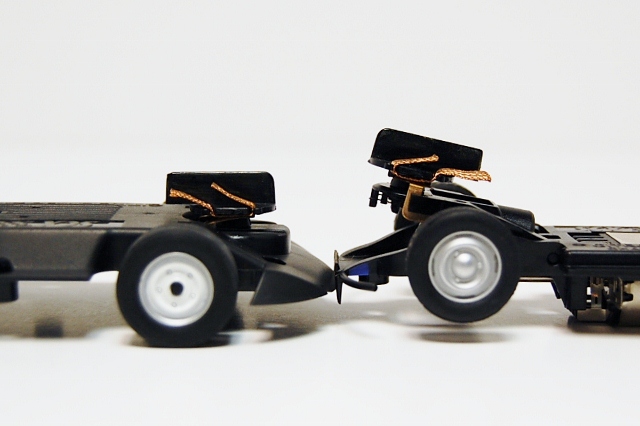
The cars also have different guide systems although I'm not clear why the drop arm guide was used on the smaller and skinner car. I have a similar
drop arm guide in a Spirit rally car that works wonderfully but in this SCX Citroen 2 CV it just seems 'gimmicky' as the car is way too held down
by the magnet to allow the drop down guide to do much and pulling the magnet out of the 2 CV its skinny, top heavy nature really makes it a
questionable handling car.
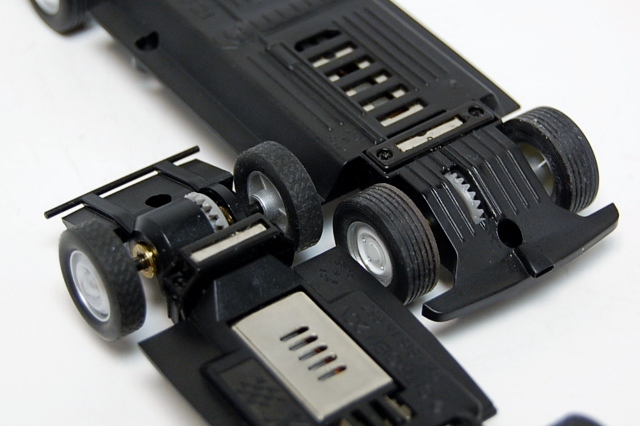
We have different magnet holders also, the longer DS 21 uses more of the traditional flush mounted bar in a screw in style holder but because the
2 CV has tthe additional gearing giving it more track clearance the protruding magnet holder gets the magnet closer to the rails than the rest
of the chassis.
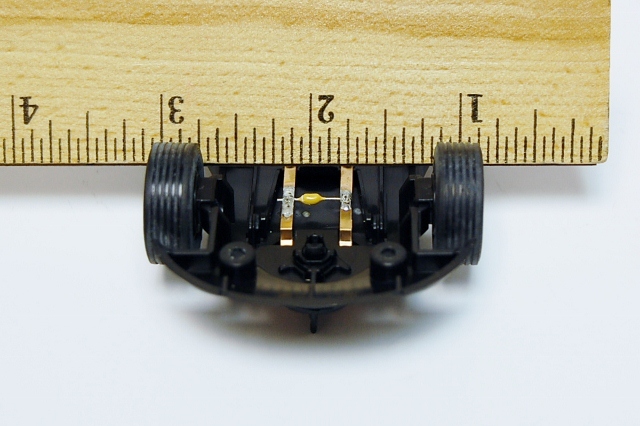
And I did mention how on both cars the front track is wider than the rear right? Here in the image above you can see that the DS 21's front track
is slightly less than two full inches. At the back (below) the track is reduced down to almost exactly an inch and a half and its a good thing
as the rear wheels have a really close clearance due to the tapering body of the car.
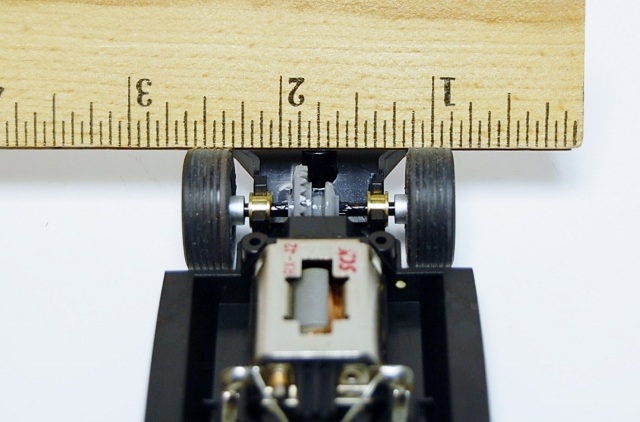
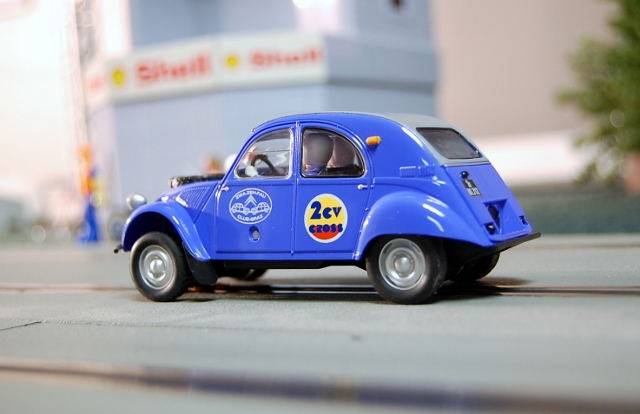
It will probably come as no surprise that neither the 2 CV or the DS21 will be record braking cars on your track. The longer and marginally wider DS 21
it by far the better handling car, both in magnet trim and non-magnet trim. In fact with the magnets out the small 2 CV becomes very difficult
to drive with any real speed as the drop down guides spring is too strong and it forces the nose of the car even higher, lifting the wheels on my
test car off of the track surface. The small 2 CV seems to find its way on to its side even in magnet trim so taking the magnet out just
increases its 'fall over' ability. Don't be fooled though in to thinking the DS 21 is a sure footed racer though. It too found its way on to its
roof on occasion but it didn't seem to bother me with the roof already being messed up.
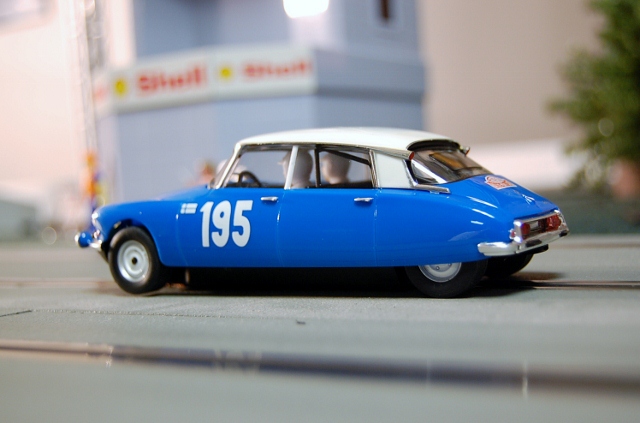
Please stop by the HomeRacingWorld.com
Message Board to talk about this and all other models of
slot cars. Happy Slotting!
Shawn Smith - SJSlots
Shawn@HomeRacingWorld.com
